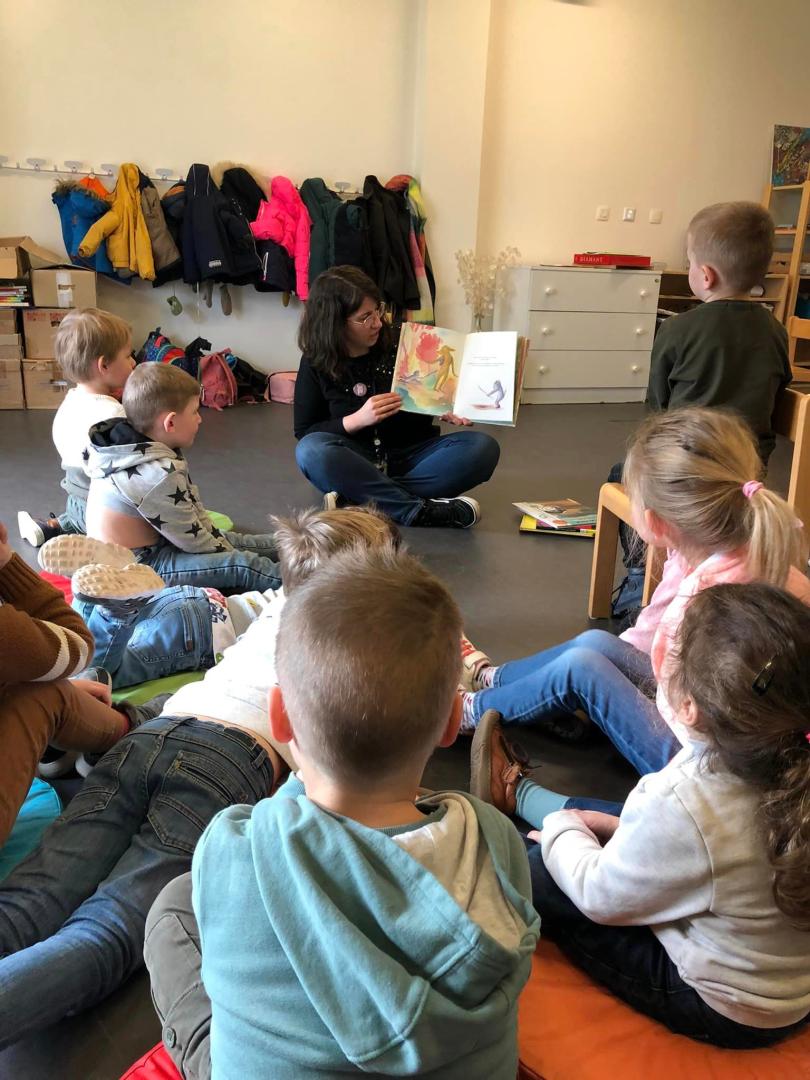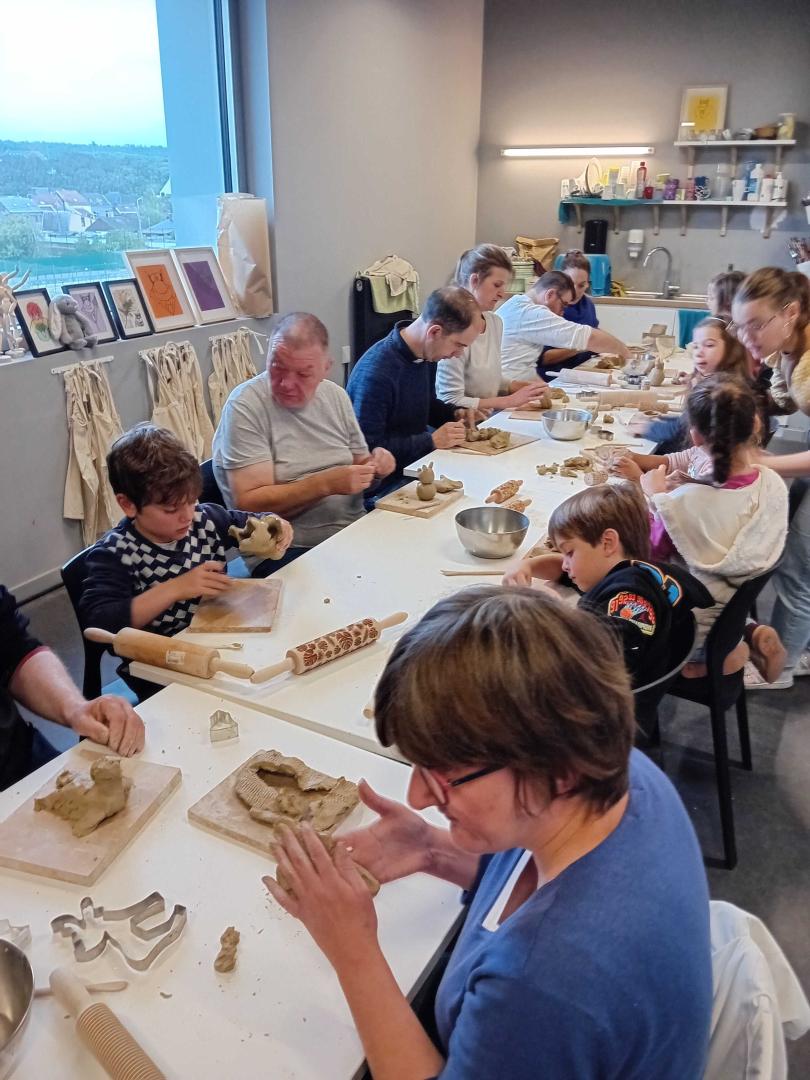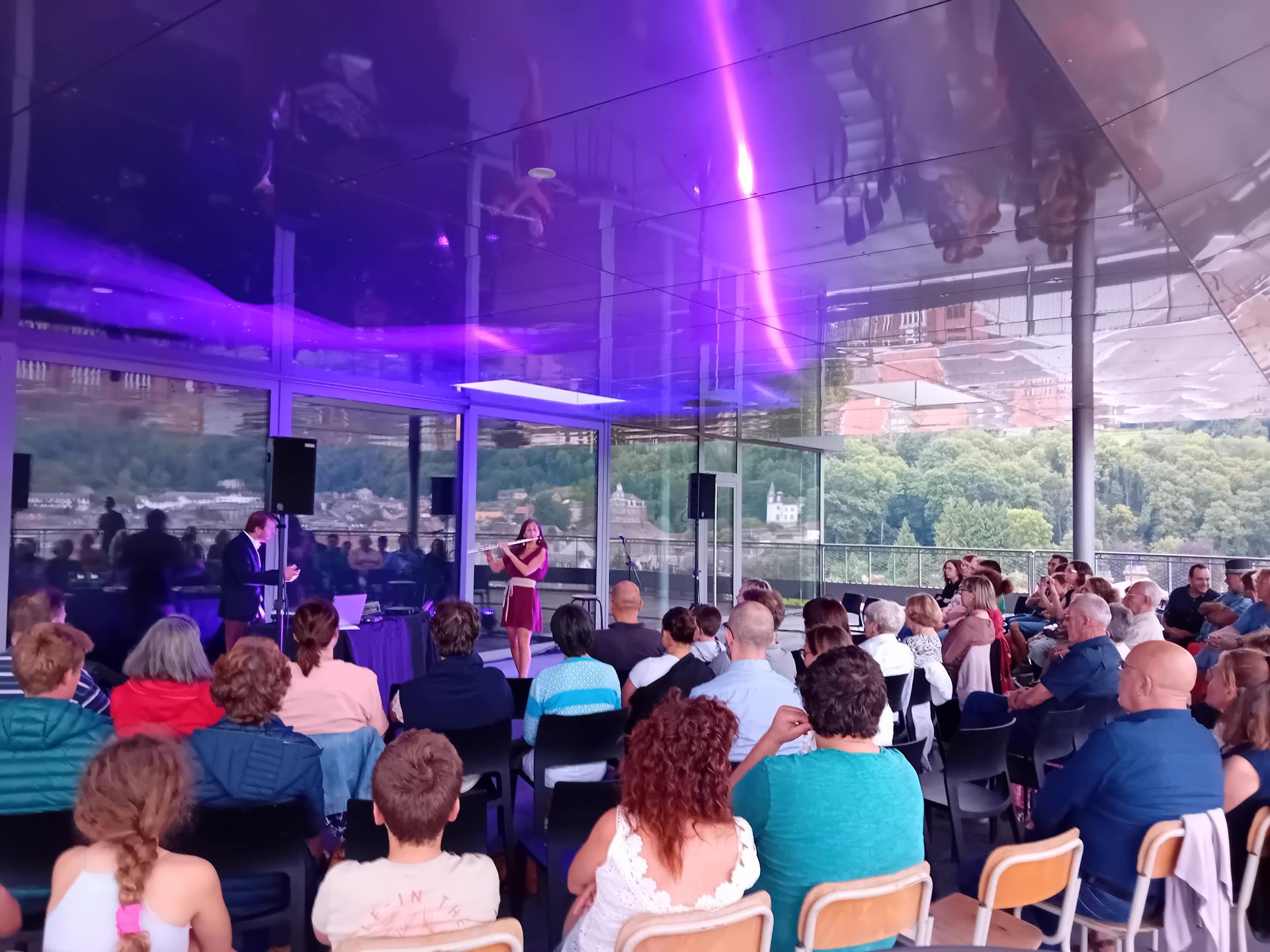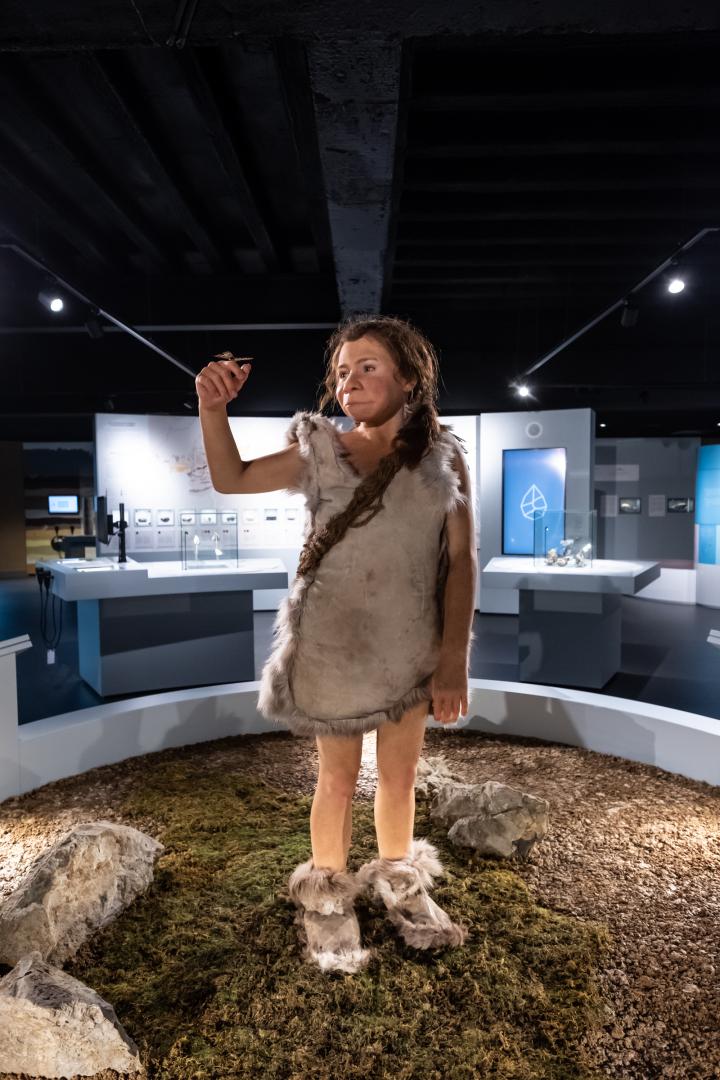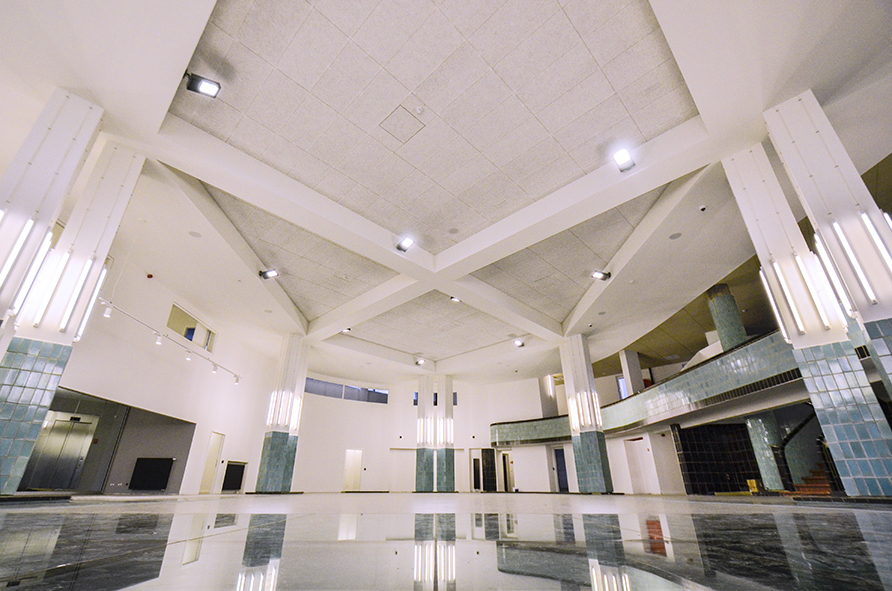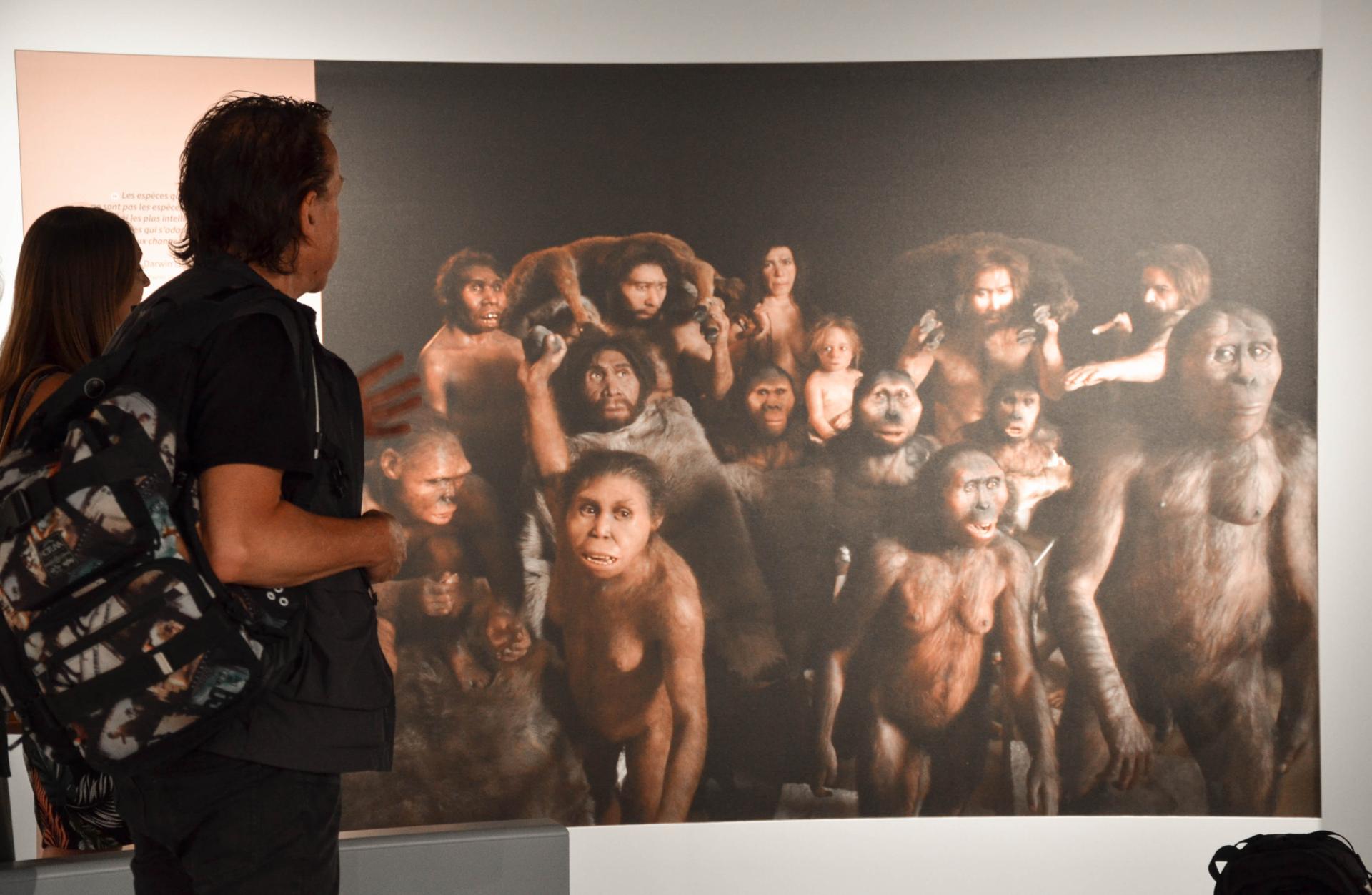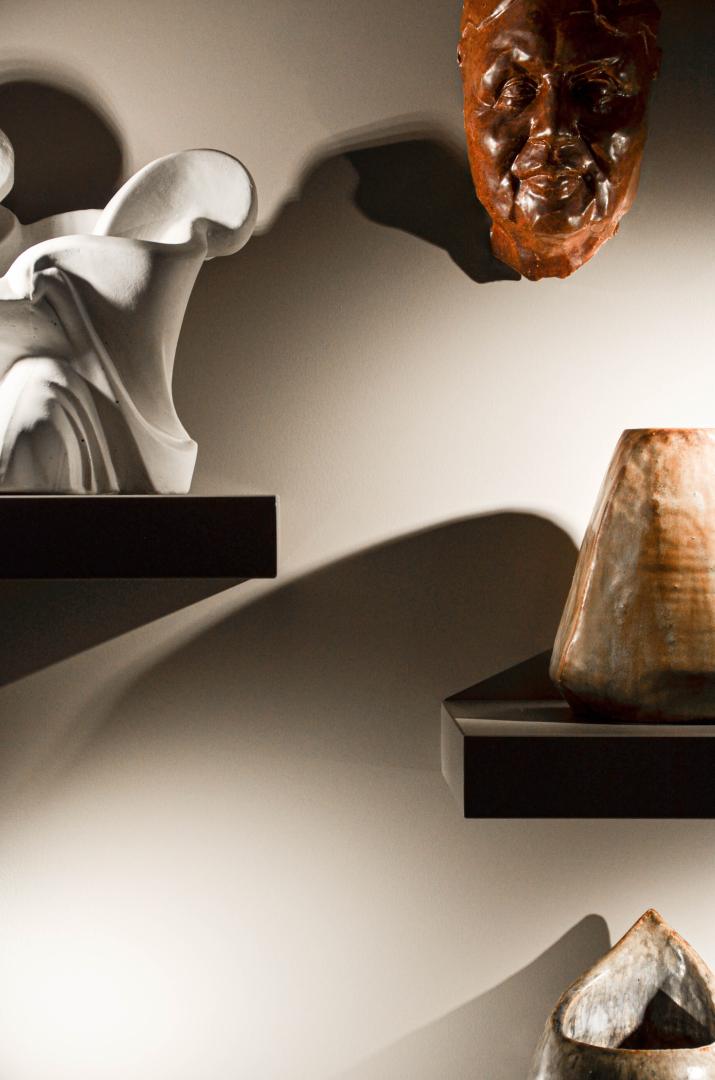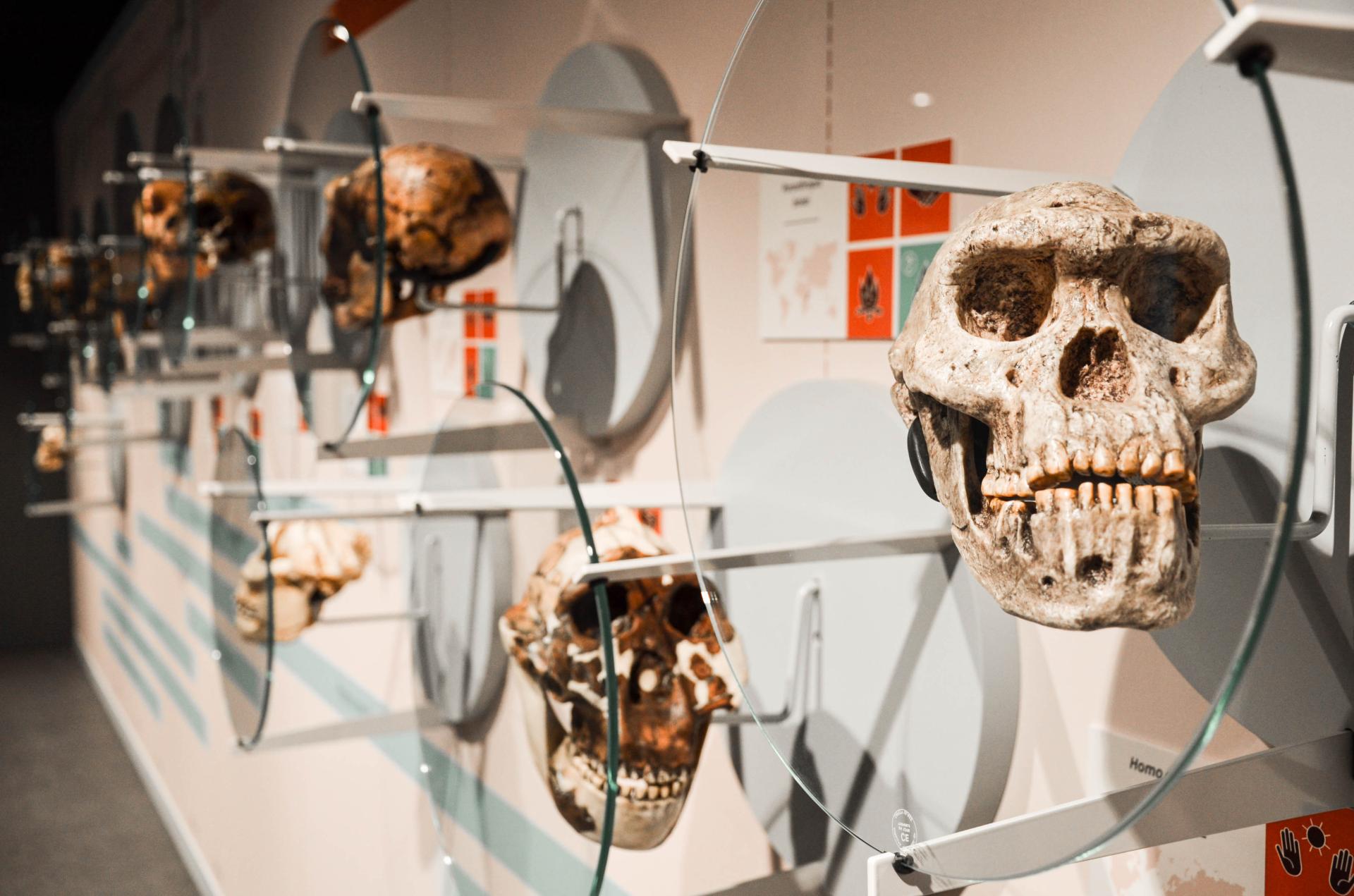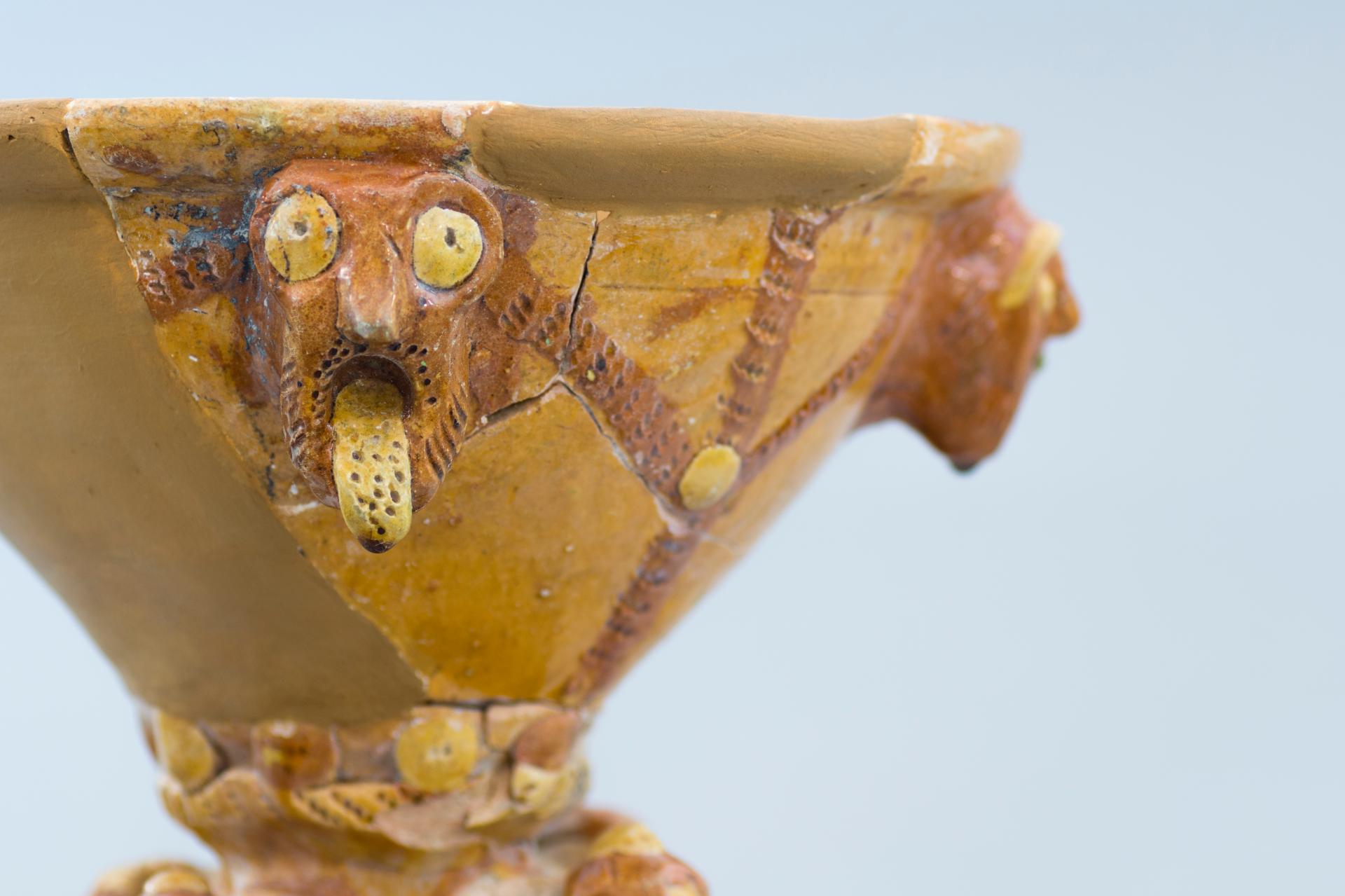Le Phare : mixing people and culture
Basic information
Project Title
Le Phare : mixing people and culture
Full project title
Le Phare – mixing culture, heritage and innovation around people
Category
Regaining a sense of belonging
Project Description
Erected in a new eco-neighborhood connected to the heart of Andenne (Belgium), “Le Phare” is the cultural hub that mixes peoples, history, heritage and creativity of an entire district. Within this amazing architectural modern masterpiece, young and old can find a preserved art Deco swimming pool hosting a public library, a tourist office which highlights local spirit and artistic dynamics, and a museum showing the richness of the territory’s prehistoric, archeological and artistic testimonies.
Geographical Scope
Local
Project Region
Andenne, Belgium
Urban or rural issues
It addresses urban-rural linkages
Physical or other transformations
It refers to a physical transformation of the built environment (hard investment)
EU Programme or fund
Yes
Which funds
ERDF : European Regional Development Fund
Description of the project
Summary
“Le Phare” is the name of a new (but historic for a part) edifice built in a recent and sustainable district in the centre of the city of Andenne (28.000 inhabitants), Wallonia, Belgium. The first and second floors integrate the lobby for visitors, information point and shop displaying ceramic artworks, in addition to the Tourist Office, and the Public Library with a reading room and a multipurpose room. From the third to the sixth floor are displayed the permanent exhibitions of the Andenne Museum (EMA): prehistory (linked to the still excavated Scladina cave: from Neandertal to Neolithic), history (from Roman times), ceramic industry and artworks, as well as workshop rooms, multipurpose rooms, temporary exhibition rooms, and a panoramic terrace.
But “Le Phare” is also the name of a non-profit organization whose purpose consists of the permanent project of mutualisation and cooperation for these three prominent actors (the Tourist office, the public library and the Andenne Museum, named “the three actors” in the following descriptions), to cross their skills and publics. A constant transversality animates the collective with a bottom-up strategy orientated to the increasing of the cultural services and experimentation of new actions. This strategy is congruous with the relationships with thinking clusters and local associations: Le Phare acts as an institution made of “porous walls” that allow new suggestions and new publics to find a place.
28 staff members (full or part-time) are involved in Le Phare and its actors: librarians, archaeologists, scientists, receptionists and shop managers, project managers, communication officers, cultural mediators, technicians…
But “Le Phare” is also the name of a non-profit organization whose purpose consists of the permanent project of mutualisation and cooperation for these three prominent actors (the Tourist office, the public library and the Andenne Museum, named “the three actors” in the following descriptions), to cross their skills and publics. A constant transversality animates the collective with a bottom-up strategy orientated to the increasing of the cultural services and experimentation of new actions. This strategy is congruous with the relationships with thinking clusters and local associations: Le Phare acts as an institution made of “porous walls” that allow new suggestions and new publics to find a place.
28 staff members (full or part-time) are involved in Le Phare and its actors: librarians, archaeologists, scientists, receptionists and shop managers, project managers, communication officers, cultural mediators, technicians…
Key objectives for sustainability
Le Phare is a technically passive building including active ventilation systems, highly efficient insulation, and full photovoltaic installation. A special attention has also been given to materials and electrical supplies. It is linked to public transports: very close to several bus lines and a fifteen minutes’ walk from a train station. The area is mainly pedestrian in order to create a feeling of safety and to promote the use of soft mobility.
The technical design of the entire facility is based on the principle of rational energy use and sustainable development. The 3,500m² building is equipped with a gas condensing boiler. It has three double-flow ventilation units with high efficiency heat recovery. In terms of building insulation, the walls and roof insulation exceed the usual standards and the wood/aluminium frames are triple glazed. 240 m² of photovoltaic panels are installed on the roof, and the building's lighting is provided by LED lights. Attention has also been paid to reducing water requirements and a recovery system has been installed to collect rainwater from the roof and terraces.
In the design of the new temporary exhibitions, special attention is paid to recycled materials. Where this is not possible, service providers are selected within a 30 km radius and sustainable materials are chosen as a priority. Thus, the scenographic furniture has several uses. The shop furniture follows the same logic. Recycling bins are available in the museum for its users. Within the offices, selective sorting is also practiced by the teams.
The choice of sustainable materials is taken into account for educational material or the printing of promotional material.
Teams are encouraged to print few hard copies of documents and to save them on a shared server. Both Museum and Library organize debates and activities about local wildlife, biodiversity, climate change, etc.; the Tourist office is the link between citizens and local nature associations and guides.
The technical design of the entire facility is based on the principle of rational energy use and sustainable development. The 3,500m² building is equipped with a gas condensing boiler. It has three double-flow ventilation units with high efficiency heat recovery. In terms of building insulation, the walls and roof insulation exceed the usual standards and the wood/aluminium frames are triple glazed. 240 m² of photovoltaic panels are installed on the roof, and the building's lighting is provided by LED lights. Attention has also been paid to reducing water requirements and a recovery system has been installed to collect rainwater from the roof and terraces.
In the design of the new temporary exhibitions, special attention is paid to recycled materials. Where this is not possible, service providers are selected within a 30 km radius and sustainable materials are chosen as a priority. Thus, the scenographic furniture has several uses. The shop furniture follows the same logic. Recycling bins are available in the museum for its users. Within the offices, selective sorting is also practiced by the teams.
The choice of sustainable materials is taken into account for educational material or the printing of promotional material.
Teams are encouraged to print few hard copies of documents and to save them on a shared server. Both Museum and Library organize debates and activities about local wildlife, biodiversity, climate change, etc.; the Tourist office is the link between citizens and local nature associations and guides.
Key objectives for aesthetics and quality
The preservation of the historic swimming pool (one of the last of this kind in Wallonia, characterized by unique turquoise ceramics) is enhanced by the audacious aesthetics of the contemporary architecture that enfolds it. Designed by Rudy Ricciotti with AIUD architectural workshop, the new building allies a contemporary design with the built heritage and connections to the territory’s identity: even the “skin” is made of modern tiles, reminding the centuries-old ceramic industry of Andenne displayed in the museum. Contemporary artists also collaborate with Le Phare, to display their more recent works. Every actors of Le Phare, from the museum (EMA) to the library and the tourist office, works in symbiosis to provide basic cultural services (to schools, and various categories of groups and visitors) as well as innovative projects fed by the network of local and regional associations, and suggestions delivered by the audiences.
Le Phare has been recognized in 2023 as a “third place” connecting peoples, heritage values, cultural fields and artistic innovation, in an inspiring dynamic. Showing that strong links between cultural actors are able to connect dissimilar themes, Le Phare acts as a bridge and a crossroad of thinking: world-class prehistoric discoveries of the Scladina cave with philosophy, clay craft with people’s identity, science and new technologies with literature, creative workshops for kids with local history, etc.
This results not only in immediate and long-term benefits for the population and the development of knowledge and artistic skills, but also in the strengthening of a feeling of pride and action aptitude for the citizens.
Le Phare has been recognized in 2023 as a “third place” connecting peoples, heritage values, cultural fields and artistic innovation, in an inspiring dynamic. Showing that strong links between cultural actors are able to connect dissimilar themes, Le Phare acts as a bridge and a crossroad of thinking: world-class prehistoric discoveries of the Scladina cave with philosophy, clay craft with people’s identity, science and new technologies with literature, creative workshops for kids with local history, etc.
This results not only in immediate and long-term benefits for the population and the development of knowledge and artistic skills, but also in the strengthening of a feeling of pride and action aptitude for the citizens.
Key objectives for inclusion
The governing system of Le Phare is mainly a transversal management involving the teams of the museum, the library, and the tourist office, into large projects that enable them to share their specific skills and experiences. Each one of these three actors remains independent in the guidance of its distinct purposes, in order not to hinder their progression and the deliverance of basic cultural services, but keeps in mind the fulfilment of a common aim through the shared projects and involvement.
This also brings together local associations and citizens included in several projects and thinking clusters, as well as the conduct of actions. For example, groups of persons with specific needs (from physic disabilities to comprehension difficulties) are building up with the help of a trained member of the EMA’s staff a process of improvement of inclusion (gears, services) for all kind of people in Le Phare. Some of them take part in the management of groups of children in periodic creative workshops. This kind of “by and for” method takes time but results in better coherence. Basically, Le Phare can count on well-designed spaces allowing disabled persons to improve its cultural main services, meanwhile, our goal is to perform even more. Working directly with people is the best method to reach a scheme suited to the needs of today’s society. The admission prices of the services are calculated in accordance to the profile of the visitors. A large part of them are free of charge: access to the library, information, access to the museum for children and others, numerous special events, etc. The aim is nothing less than allowing as many different kinds of people as possible to come into, take advantage of, and contribute to Le Phare. What is starting to emerge is a crossing of different people, sharing a cultural place, cultural meanings, and soon cultural self-conducted actions. This objective mirrors some of the precepts of the transversal management clarified above.
This also brings together local associations and citizens included in several projects and thinking clusters, as well as the conduct of actions. For example, groups of persons with specific needs (from physic disabilities to comprehension difficulties) are building up with the help of a trained member of the EMA’s staff a process of improvement of inclusion (gears, services) for all kind of people in Le Phare. Some of them take part in the management of groups of children in periodic creative workshops. This kind of “by and for” method takes time but results in better coherence. Basically, Le Phare can count on well-designed spaces allowing disabled persons to improve its cultural main services, meanwhile, our goal is to perform even more. Working directly with people is the best method to reach a scheme suited to the needs of today’s society. The admission prices of the services are calculated in accordance to the profile of the visitors. A large part of them are free of charge: access to the library, information, access to the museum for children and others, numerous special events, etc. The aim is nothing less than allowing as many different kinds of people as possible to come into, take advantage of, and contribute to Le Phare. What is starting to emerge is a crossing of different people, sharing a cultural place, cultural meanings, and soon cultural self-conducted actions. This objective mirrors some of the precepts of the transversal management clarified above.
Results in relation to category
Le Phare opened in the midst of pandemy, in June 2020. Meanwhile, our rising is remarkable.
2022-2023: processes for the EMA as “level A” (highest rank) and of the Library’s public certification by Wallonia-Brussels Federation
January 2023: Le Phare recognized as “Third place in a rural area”; our experience stimulates some similar projects
April 2023: EMA in the short-list of the European Museum of the Year 2022 (EMYA)
May 2023: certification “Access-I” (high standard of facilities for disabled people)
Audience of the EMA’s exhibitions 2022: 18.496 (growing from less than 5.000 a year in the museums before inclusion in the project Le Phare in 2020): public find quickly its place
Audience of the EMA’s cultural services 2022 (among all admissions): 7292. To the Library’s cultural services 2022: 1962. Schools and particular groups identify Le Phare as a place for learning and acting
Tourist office audience: more than 2.000 (without events); library’s book loans 2022: more than 36.000.
33 events planned in 2023 (including : international Ceramic Market of Andenne, European Museum’s Night, Heritage’s Days, Wallonia’s Festival, Wallonia’s Days of Archaeology, Christmas in Le Phare…) : Le Phare joins the main events and initiates its owns
6 exhibitions in 2023, mastered by the EMA or the Library
53 worskhops planned in 2023 (some of them recurrent): Le Phare is a place for expression, and work with children and citizens
More than 60 meetings (strategy, planning, communication, plenary, etc.) crossing teams since 2020: non-stop dialogue and management experimentation
Partnerships with more than 15 high-ranked universities and research centres (including Oxford, Leiden, Leipzig…): EMA stands with the highest levels of science
Links with more than 10 associations for projects in 2022 aimed at socially and culturally disadvantaged groups, and more than 20 strong local cultural an touristic partnerships: Le Phare becomes a model and a hub of partnerships.
2022-2023: processes for the EMA as “level A” (highest rank) and of the Library’s public certification by Wallonia-Brussels Federation
January 2023: Le Phare recognized as “Third place in a rural area”; our experience stimulates some similar projects
April 2023: EMA in the short-list of the European Museum of the Year 2022 (EMYA)
May 2023: certification “Access-I” (high standard of facilities for disabled people)
Audience of the EMA’s exhibitions 2022: 18.496 (growing from less than 5.000 a year in the museums before inclusion in the project Le Phare in 2020): public find quickly its place
Audience of the EMA’s cultural services 2022 (among all admissions): 7292. To the Library’s cultural services 2022: 1962. Schools and particular groups identify Le Phare as a place for learning and acting
Tourist office audience: more than 2.000 (without events); library’s book loans 2022: more than 36.000.
33 events planned in 2023 (including : international Ceramic Market of Andenne, European Museum’s Night, Heritage’s Days, Wallonia’s Festival, Wallonia’s Days of Archaeology, Christmas in Le Phare…) : Le Phare joins the main events and initiates its owns
6 exhibitions in 2023, mastered by the EMA or the Library
53 worskhops planned in 2023 (some of them recurrent): Le Phare is a place for expression, and work with children and citizens
More than 60 meetings (strategy, planning, communication, plenary, etc.) crossing teams since 2020: non-stop dialogue and management experimentation
Partnerships with more than 15 high-ranked universities and research centres (including Oxford, Leiden, Leipzig…): EMA stands with the highest levels of science
Links with more than 10 associations for projects in 2022 aimed at socially and culturally disadvantaged groups, and more than 20 strong local cultural an touristic partnerships: Le Phare becomes a model and a hub of partnerships.
How Citizens benefit
Le Phare and its institutional actors are continually confronted with the necessity of a combination of movements: bottom-up approach and top-down policies. Giving access to archaeological pieces and interpretations, scientific discourses, books and informations of all kinds, may essentially seem to be mainly a top-down movement. Meanwhile, each activity, from the school visit to the literary lecture, includes a part of active contribution by the participants, set accordingly to the concern and practical potential. As we pointed out above, local groups of interests gathering citizens and members of the society (persons with disabilities, Reading Development Committee, Scientific Committee, etc.), and associations, contribute to the development of the activities of the actors and to the evolution of the infrastructure. The strategic plans of the institutional actors of Le Phare covering four or five-years periods are highly impacted by these fields or outer experiences, and are designed to shape the action for the following years.
But this is not only a matter of planification, since new initiatives can find in Le Phare an open door and an assistance. We can mention for example: a presentation of rapid prototypers by the local fab lab, an escape room game for young archaeologists in the museum by Archeolo-J, a “ceramic café” gathering artists and public around contemporary creations by ArtBol, singing and dance experience by “Sing for the moment” in the library, etc.
The project “Eclat(s)”, mastered by EMA and Le Phare with several artists and associations, was designed to collect in the town and the villages of the district, via interviews, poetry and music, the personal and collective memories of the citizens linked to their personal pottery items. Experiment is a master word for the present and the aspired future of Le Phare, but we won’t be able to build it without a work involving the cultural, societal and creative forces of the territory and outside.
But this is not only a matter of planification, since new initiatives can find in Le Phare an open door and an assistance. We can mention for example: a presentation of rapid prototypers by the local fab lab, an escape room game for young archaeologists in the museum by Archeolo-J, a “ceramic café” gathering artists and public around contemporary creations by ArtBol, singing and dance experience by “Sing for the moment” in the library, etc.
The project “Eclat(s)”, mastered by EMA and Le Phare with several artists and associations, was designed to collect in the town and the villages of the district, via interviews, poetry and music, the personal and collective memories of the citizens linked to their personal pottery items. Experiment is a master word for the present and the aspired future of Le Phare, but we won’t be able to build it without a work involving the cultural, societal and creative forces of the territory and outside.
Physical or other transformations
It refers to a physical transformation of the built environment (hard investment)
Innovative character
Many cultural places are devoted to a unique cluster of methods and themes, or consist of the addition of these methods and themes without a real combination. One of the parts often takes advantage of a prominent position to constrain the others. Le Phare pays attention to the conjunction of all of them, by a balancing method between proper aims of its actors and the common purpose. This is nothing less than a democratic experimentation at a high level, permitting outer actors to “hustle” our principles and practises.
Museums usually display art and evidences. Libraries provide books. Tourist offices provide information and advices. The actors of Le Phare act deeper, persistently, because they can rely on other teams’ skills, and on the contribution of the citizens. Culture lies not only in knowledge and pieces “revealed”, but also in material and thinking products constructed by those who enter the place. No one should de facto be dismissed from this potential of expression. These mantras expose by themselves the importance of accessibility for the building and the services, and of the porosity and dialogue at every level of the project. But the benefit should not only be individual, it should also be common.
Thus, every form of expression, craft, contemporary art, literature, debate, board or video game, can find a space in Le Phare, while maintaining strongly and efficiently the basic work of its actors and teams. New suggestions are not competitors for their identities: they feed them. There isn’t any fear of experimentation when everyone is aware of the other’s need and intention. Porosity is the guarantee of constant reinterpretation. We do not really know what the future of Le Phare will be, but it shall be common.
Museums usually display art and evidences. Libraries provide books. Tourist offices provide information and advices. The actors of Le Phare act deeper, persistently, because they can rely on other teams’ skills, and on the contribution of the citizens. Culture lies not only in knowledge and pieces “revealed”, but also in material and thinking products constructed by those who enter the place. No one should de facto be dismissed from this potential of expression. These mantras expose by themselves the importance of accessibility for the building and the services, and of the porosity and dialogue at every level of the project. But the benefit should not only be individual, it should also be common.
Thus, every form of expression, craft, contemporary art, literature, debate, board or video game, can find a space in Le Phare, while maintaining strongly and efficiently the basic work of its actors and teams. New suggestions are not competitors for their identities: they feed them. There isn’t any fear of experimentation when everyone is aware of the other’s need and intention. Porosity is the guarantee of constant reinterpretation. We do not really know what the future of Le Phare will be, but it shall be common.
Disciplines/knowledge reflected
Concerning the diversity of the missions of the actors of Le Phare (EMA, library, tourist office), the fields covered are incredibly varied. The common work of the teams enables the categorization of these shared global aims:
Research and increase of knowledge about prehistory, local history, traditions, citizen’s life
Transmission of knowledge and practices (scientific and cultural) to the publics in their diversity
Illustration of the creativity and skills of the citizens and actual artists an encouragement to their action
Display of the territorial assets, and tangible and intangible heritage that can be reclaimed by citizens
Promotion of sciences, innovation, culture, and self-expression
The Museum of Andenne (EMA) is a museum of the territory, a player in its evolution. Beside its permanent exhibition showing the richness of its archaeological, (pre)historical, and artistic evidence, cultural mediation provides the guided tours, workshops and projects for different publics, and research (prehistory, archaeology, ceramology) is a prominent component of its missions. The skills of the dedicated teams allow them to correspond with world-class scientists, which is remarkable for such a small-scale museum.
The Library provides books of all kinds, as well as writing and creative workshops.
The Tourist office is not only devoted to foreign visitors, but also to the local citizens with a contribution to the villages’ life improvement and the maintaining of folklore and traditions, etc.
Le Phare’s mission is to detect with the actors the points of convergence in/of all these actions. For example, attention to people with so-called special needs to habits of working with citizens and associations, commitment to an easy and complete access for the school audience, are some of the common intent definitely shared. The five global aims displayed above are incorporated into complementary or mutual actions, empowering and enlightening every field covered.
Research and increase of knowledge about prehistory, local history, traditions, citizen’s life
Transmission of knowledge and practices (scientific and cultural) to the publics in their diversity
Illustration of the creativity and skills of the citizens and actual artists an encouragement to their action
Display of the territorial assets, and tangible and intangible heritage that can be reclaimed by citizens
Promotion of sciences, innovation, culture, and self-expression
The Museum of Andenne (EMA) is a museum of the territory, a player in its evolution. Beside its permanent exhibition showing the richness of its archaeological, (pre)historical, and artistic evidence, cultural mediation provides the guided tours, workshops and projects for different publics, and research (prehistory, archaeology, ceramology) is a prominent component of its missions. The skills of the dedicated teams allow them to correspond with world-class scientists, which is remarkable for such a small-scale museum.
The Library provides books of all kinds, as well as writing and creative workshops.
The Tourist office is not only devoted to foreign visitors, but also to the local citizens with a contribution to the villages’ life improvement and the maintaining of folklore and traditions, etc.
Le Phare’s mission is to detect with the actors the points of convergence in/of all these actions. For example, attention to people with so-called special needs to habits of working with citizens and associations, commitment to an easy and complete access for the school audience, are some of the common intent definitely shared. The five global aims displayed above are incorporated into complementary or mutual actions, empowering and enlightening every field covered.
Methodology used
Communication about the objectives and actions of every team’s members is the first step of all cooperation movement, and Le Phare is the key to the transmission and comprehension of information. Living the significant moments of the three actors (development of the exhibitions and events, engagement in the strategic processes, continuous learning…) feeds the understanding of other realities and depict the importance of every component of the teams, from the receptionist to the archaeologists in the Scladina cave. This dialogue is crucial for a high level of consideration.
Constant meetings between the supervisors of the three actors and Le Phare are decisive to evaluate the achieving of sectional and global goals, and define the next steps. Numerous other meetings involving the teams, and outer actors (as well as citizens and private sector, as depicted above), allow us to establish integrated projects in every domain (communication, relationship with associations and politics, adaptation to special needs of publics, events, training, staffing policies and recruitment, governance structure, etc.): identification of the common aims, publics, resources.
Sometimes the initiatives do not emerge from Le Phare, but from an outer partner. We can mention for example the International Ceramic Triennale managed by Ceramic Art Andenne (Cultural center): Le Phare, the EMA and the Tourist Office are directly involved, and the Library at a more minor level. We have to observe the same rigour in communication, identification of the aims, etc.
We pay attention to reflect the image of Le Phare as a place, and an integrated project, but also the image of the three actors. For research results, the image of the EMA is the first one put forward, as well as the image of the Tourist Office and more globally of Andenne as a destination. Le Phare is the prominent figure to illustrate a “third place” project. External communication needs recurrent balancing and shared resolutions.
Constant meetings between the supervisors of the three actors and Le Phare are decisive to evaluate the achieving of sectional and global goals, and define the next steps. Numerous other meetings involving the teams, and outer actors (as well as citizens and private sector, as depicted above), allow us to establish integrated projects in every domain (communication, relationship with associations and politics, adaptation to special needs of publics, events, training, staffing policies and recruitment, governance structure, etc.): identification of the common aims, publics, resources.
Sometimes the initiatives do not emerge from Le Phare, but from an outer partner. We can mention for example the International Ceramic Triennale managed by Ceramic Art Andenne (Cultural center): Le Phare, the EMA and the Tourist Office are directly involved, and the Library at a more minor level. We have to observe the same rigour in communication, identification of the aims, etc.
We pay attention to reflect the image of Le Phare as a place, and an integrated project, but also the image of the three actors. For research results, the image of the EMA is the first one put forward, as well as the image of the Tourist Office and more globally of Andenne as a destination. Le Phare is the prominent figure to illustrate a “third place” project. External communication needs recurrent balancing and shared resolutions.
How stakeholders are engaged
The City Council of Andenne launched the renovation of the historic swimming pool and the design of the building with the assistance of the Public Service of Wallonia (SPW) and the European Regional Development Fund (ERDF). This means investment in collaboration and financing, as well as (with active role of the teams of the museums, the library, the tourist office, and the local authority) elaboration of the aims and cooperation structure of Le Phare. Outer assistance from scientific, cultural and social partners (among them the Brussels-Wallonia Federation) fed the deliberations.
At every level, from the field necessities to the strategic prospect, these actors’ contribution was significant. Without the awareness of the ERDF and the SPW, the cultural project wouldn’t have reached its actual level, but it would also be impossible to anticipate it if the museum, the library, and the tourist office, with the help of many other actors, had not provided what was the particular aim of their field.
The City Council of Andenne devoted itself to the gathering of all these partners, and created the conditions for clear and balanced collegiate decisions, but ultimately devolved this role to “Le Phare”. This newly created non-profit organization (ASBL = NPO) has been appointed to manage the co-living of the actors in the building, alongside its maintenance and development; but Le Phares’s main mission is the clustering of the resources and common services with a view to increase efficiency and practice sharing. The transversal management has permitted to answer to new and old challenges with fresh and collective solutions.
The City Council of Andenne still closely accompanies the program, and the distinct services of the Wallonia Government and the Brussels-Wallonia Government are also associated (accreditation and financial backing for the EMA, the library and the tourist office, funding for projects and research, funding as a “third place in a rural area”, etc.)
At every level, from the field necessities to the strategic prospect, these actors’ contribution was significant. Without the awareness of the ERDF and the SPW, the cultural project wouldn’t have reached its actual level, but it would also be impossible to anticipate it if the museum, the library, and the tourist office, with the help of many other actors, had not provided what was the particular aim of their field.
The City Council of Andenne devoted itself to the gathering of all these partners, and created the conditions for clear and balanced collegiate decisions, but ultimately devolved this role to “Le Phare”. This newly created non-profit organization (ASBL = NPO) has been appointed to manage the co-living of the actors in the building, alongside its maintenance and development; but Le Phares’s main mission is the clustering of the resources and common services with a view to increase efficiency and practice sharing. The transversal management has permitted to answer to new and old challenges with fresh and collective solutions.
The City Council of Andenne still closely accompanies the program, and the distinct services of the Wallonia Government and the Brussels-Wallonia Government are also associated (accreditation and financial backing for the EMA, the library and the tourist office, funding for projects and research, funding as a “third place in a rural area”, etc.)
Global challenges
Together with other projects in Europe based on democratic experimentation between institutions, and the notion of “third place”, Le Phare may contribute to a redefinition of the positioning of culture and the people that construct it. Though very local (little city, not situated on the official maps of great tourism and great culture), our project participates to an extremely large democratic reconstruction. People convinced by the richness of their history, by the human and material resources of their territory, or those that surround them, and allowed to explore their own potential and are much more orientated towards the materialisation of personal expression and action. As tiny as these expressions and actions may seem, they play a role in an extensive challenge for present and future generations.
We are surrounded by many “top-down” cultural institutions, or large exhibitions of “cultural entertainment”, but we need more. We need a policy of culture balancing between excellence, delight, popular references, and self-practise. The solutions we are steadily constructing with our partners provide some answers to these needs of today’s society. Moreover, mixing various people by giving them an access and a special position in Le Phare is the best way to stimulate the dialogue, and recognition of everyone’s rights and legitimacy.
This recognition of the citizens’ legitimacy in the practice of their rights is the key to the reconstruction of a strong link between them and the public policies. Culture can initiate it, and accompany it, if maintaining its integrity in defending these claims (in this respect, the continuity of a genuine cross-functional governance based on equality is fundamental), and opening large fields of thought and action. This is the design that the European Union requires for its ongoing democratic regeneration.
We are surrounded by many “top-down” cultural institutions, or large exhibitions of “cultural entertainment”, but we need more. We need a policy of culture balancing between excellence, delight, popular references, and self-practise. The solutions we are steadily constructing with our partners provide some answers to these needs of today’s society. Moreover, mixing various people by giving them an access and a special position in Le Phare is the best way to stimulate the dialogue, and recognition of everyone’s rights and legitimacy.
This recognition of the citizens’ legitimacy in the practice of their rights is the key to the reconstruction of a strong link between them and the public policies. Culture can initiate it, and accompany it, if maintaining its integrity in defending these claims (in this respect, the continuity of a genuine cross-functional governance based on equality is fundamental), and opening large fields of thought and action. This is the design that the European Union requires for its ongoing democratic regeneration.
Learning transferred to other parties
We are deeply convinced that this model based on porosity between distinct fields, transversal governance, involvement of citizens and civil society, and attention to environment as well as special needs of people, could be replicated. Replicated doesn’t mean mirrored. The context of Le Phare, Andenne and its surroundings, and the background and structures of the three actors, are quite unique and give a definitive shape to our project.
Meanwhile, several existent or envisaged projects of “culture crossroads” have paid attention to our (still in progress, to be fair) model and visited our installations. We are always pleased to meet them and integrate their particular point of view to our experience. The basic principle of very various actors united, not by coercion, but by the simple and practical impulse “we play collective whenever it enforces our action and our publics, and seek for every possibility of collective enhancement”, is particularly appreciated, beside the transversal management culture treating anyone equally in their importance for the project. And Le Phare, as a non-profit organization responsible for the coordination of the actors, is also an equal and not a head, it “slips” between the partners to encourage the conditions of dialogue.
We often take advantage of the experience delivered by structures established longer ago than ours, but our teams are regularly, more and more, consulted for their practices (with people presenting disabilities, people distant from cultural institutions, with surrounding people, for the work on prehistoric archaeology, on ceramology, etc.). It would be a delight to accompany several analogous projects, and to create a large team across the frontiers.
Meanwhile, several existent or envisaged projects of “culture crossroads” have paid attention to our (still in progress, to be fair) model and visited our installations. We are always pleased to meet them and integrate their particular point of view to our experience. The basic principle of very various actors united, not by coercion, but by the simple and practical impulse “we play collective whenever it enforces our action and our publics, and seek for every possibility of collective enhancement”, is particularly appreciated, beside the transversal management culture treating anyone equally in their importance for the project. And Le Phare, as a non-profit organization responsible for the coordination of the actors, is also an equal and not a head, it “slips” between the partners to encourage the conditions of dialogue.
We often take advantage of the experience delivered by structures established longer ago than ours, but our teams are regularly, more and more, consulted for their practices (with people presenting disabilities, people distant from cultural institutions, with surrounding people, for the work on prehistoric archaeology, on ceramology, etc.). It would be a delight to accompany several analogous projects, and to create a large team across the frontiers.
Keywords
Cultural experimentation
"Porosity"
Partnerships
Citizenship
Roots

